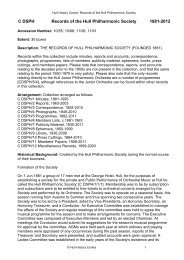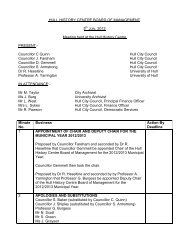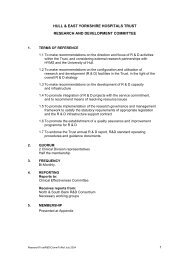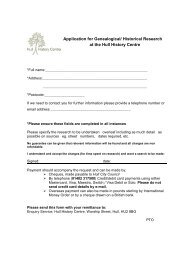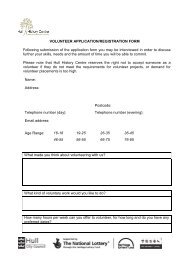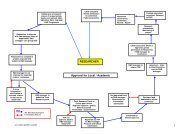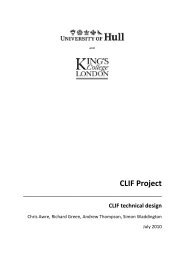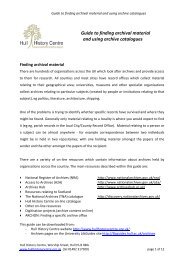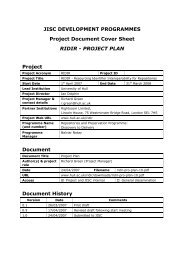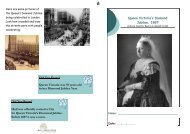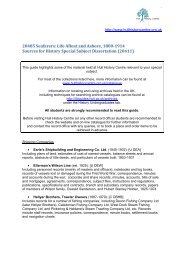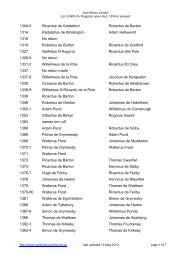Aquatic Ecosystem Health & Management - Hull History Centre
Aquatic Ecosystem Health & Management - Hull History Centre
Aquatic Ecosystem Health & Management - Hull History Centre
Create successful ePaper yourself
Turn your PDF publications into a flip-book with our unique Google optimized e-Paper software.
This article was downloaded by:[Cowx, I. G.]<br />
On: 26 November 2007<br />
Access Details: [subscription number 787301574]<br />
Publisher: Taylor & Francis<br />
Informa Ltd Registered in England and Wales Registered Number: 1072954<br />
Registered office: Mortimer House, 37-41 Mortimer Street, London W1T 3JH, UK<br />
<strong>Aquatic</strong> <strong>Ecosystem</strong> <strong>Health</strong> &<br />
<strong>Management</strong><br />
Publication details, including instructions for authors and subscription information:<br />
http://www.informaworld.com/smpp/title~content=t713393886<br />
The role of the freshwater shrimp Caridina nilotica<br />
(Roux) in the diet of the major commercial fish species<br />
in Lake Victoria, Tanzania<br />
Y. L. Budeba ab ; I. G. Cowx c<br />
a Tanzania Fisheries Research Institute, Kyela, Tanzania<br />
b TAFIRI, Dar-es-Salaam, Tanzania<br />
c <strong>Hull</strong> International Fisheries Institute, University of <strong>Hull</strong>, England<br />
Online Publication Date: 01 October 2007<br />
To cite this Article: Budeba, Y. L. and Cowx, I. G. (2007) 'The role of the freshwater<br />
shrimp Caridina nilotica (Roux) in the diet of the major commercial fish species in<br />
Lake Victoria, Tanzania', <strong>Aquatic</strong> <strong>Ecosystem</strong> <strong>Health</strong> & <strong>Management</strong>, 10:4, 368 - 380<br />
To link to this article: DOI: 10.1080/14634980701703876<br />
URL: http://dx.doi.org/10.1080/14634980701703876<br />
PLEASE SCROLL DOWN FOR ARTICLE<br />
Full terms and conditions of use: http://www.informaworld.com/terms-and-conditions-of-access.pdf<br />
This article maybe used for research, teaching and private study purposes. Any substantial or systematic reproduction,<br />
re-distribution, re-selling, loan or sub-licensing, systematic supply or distribution in any form to anyone is expressly<br />
forbidden.<br />
The publisher does not give any warranty express or implied or make any representation that the contents will be<br />
complete or accurate or up to date. The accuracy of any instructions, formulae and drug doses should be<br />
independently verified with primary sources. The publisher shall not be liable for any loss, actions, claims, proceedings,<br />
demand or costs or damages whatsoever or howsoever caused arising directly or indirectly in connection with or<br />
arising out of the use of this material.
Downloaded By: [Cowx, I. G.] At: 19:49 26 November 2007<br />
The role of the freshwater shrimp Caridina nilotica<br />
(Roux) in the diet of the major commercial fish species<br />
in Lake Victoria, Tanzania<br />
Y. L. Budeba 1† and I. G. Cowx 2∗<br />
1 Tanzania Fisheries Research Institute,P.O. Box 98 Kyela, Tanzania.<br />
2 <strong>Hull</strong> International Fisheries Institute, University of <strong>Hull</strong> HU6 7RX, England<br />
† Current address: TAFIRI, Dar-es-Salaam, Tanzania<br />
∗ Corresponding author: i.g.cowx@hull.ac.uk<br />
The major commercial fish species of Lake Victoria at the present time are Lates niloticus, Oreochromis<br />
niloticus and Rastrineobola argentea. The contribution of Caridina nilotica in their diet was studied in<br />
the Tanzanian waters of Lake Victoria between March, 1999 and January, 2002. Stomach samples were<br />
collected during routine bottom trawl surveys in Tanzania. The results show that haplochromines dominate<br />
the diet of Nile perch, followed by C. nilotica, R. argentea, juvenile Nile perch, fish remains and other<br />
prey. Caridina nilotica predominance in diets decreased as size of the Nile perch increased, as this species<br />
switched to haplochromines. Larger perch also feed on their own juveniles. The importance of C. nilotica<br />
in the diet of L. niloticus wasrelatively greater in deeper water than that in shallower stations.<br />
The diet of O. niloticus was predominantly algae followed by C. nilotica, dagaa, Chaoborus, Odonata<br />
and others. O. niloticus has shifted its diet from strictly herbivory to a more omnivorous diet, feeding<br />
opportunistically on the most available food material.<br />
The overall diet of R. argentea waspredominantly copepods, followed by Chaoborus, Cladocera, C. nilotica,<br />
Chironomids and insects. In the present food web, C. nilotica is an important food source for the fish<br />
stocks of Lake Victoria. The sustainability of the fisheries of Lake Victoria depends among other things on<br />
the abundance and availability of C. nilotica.<br />
Keywords: Feeding habits, Nile perch, Nile tilapia, dagaa<br />
Introduction<br />
Currently, the main commercial fish species of<br />
Lake Victoria are Lates niloticus, Oreochromis<br />
niloticus, Rastrineobola argentea and the haplochromine<br />
cichlids (Budeba, 2003). The diet of<br />
L. niloticus has been the subject of many detailed<br />
studies (Ligtvoet and Mkumbo, 1990; Mkumbo<br />
and Ligtvoet, 1992; Ogutu Ohwayo, 1985, 1990a,<br />
1990b; Hughes, 1986; Ogari and Dadzie, 1988;<br />
Owili, 1999). Their results indicate that its food<br />
preference has changed from haplochromine cichlids<br />
to C. nilotica, R. argentea, juvenile L. niloticus<br />
and insects. In the research undertaken so far, the<br />
importance of C. nilotica in the diet of the main<br />
fish species has received little attention (Budeba,<br />
2003).<br />
The objective of this paper is to assess the spatial<br />
and temporal importance of C. nilotica in the<br />
diet of various size classes of the major commercial<br />
fish species in the Tanzanian waters of Lake<br />
Victoria.<br />
368<br />
<strong>Aquatic</strong> <strong>Ecosystem</strong> <strong>Health</strong> & <strong>Management</strong>, 10(4):368–380, 2007. Copyright C○ 2007 AEHMS. ISSN: 1463-4988 print / 1539-4077 online<br />
DOI: 10.1080/14634980701703876
Budeba and Cowx / <strong>Aquatic</strong> <strong>Ecosystem</strong> <strong>Health</strong> and <strong>Management</strong> 10 (2007) 368–380 369<br />
Downloaded By: [Cowx, I. G.] At: 19:49 26 November 2007<br />
Materials and methods<br />
Study area<br />
The Tanzanian part of Lake Victoria is usually divided<br />
into three sampling zones (A, B, C) (Figure 1).<br />
Zone A stretches from Kome and Buhiru islands in<br />
the southwest, and northeastwards to the south west<br />
of Ukerewe island, including the Speke and Mwanza<br />
Gulfs. Zone B starts from the Tanzania-Kenya border<br />
southwards to the north west of Ukerewe Island.<br />
Zone C covers the Kagera waters from Rubafu Bay<br />
on the Tanzania-Uganda border southwards to Kome<br />
Island, including the Emin Pasha Gulf. These three<br />
zones were sampled over 14-day periods, on a quarterly<br />
basis.<br />
Sampling programme<br />
The diet study was conducted between March,<br />
1999 and January, 2002. Fish stomachs were collected<br />
during routine quarterly bottom trawl surveys<br />
in each of the three sampling zones. Trawling was<br />
done during the daytime for a period of fourteen<br />
days per area per month, using RV Lake Victoria Explorer,<br />
(length 17 m; 250 H.P.). The catch was sorted<br />
into commercial categories. Depending on the size<br />
of the catch, from one or two hauls, specimens of<br />
Nile perch, Nile tilapia, dagaa and haplochromines<br />
were dissected on a daily basis for sex/maturity<br />
and dietary analysis. Entire guts were removed and<br />
individual stomachs examined separately. For the<br />
stomach analysis, the points method (Hynes, 1950;<br />
Figure 1. Map of Lake Victoria with the sampling zones of the Tanzanian sector.
Downloaded By: [Cowx, I. G.] At: 19:49 26 November 2007<br />
370 Budeba and Cowx / <strong>Aquatic</strong> <strong>Ecosystem</strong> <strong>Health</strong> and <strong>Management</strong> 10 (2007) 368–380<br />
Figure 2. Monthly composition of the diet of Lates niloticus, March 1999–January 2002 (sample sizes are shown on top of the bars).<br />
Hyslop, 1980) was used to determine the contribution<br />
of each prey item to the diet (Figure 2). The<br />
food items were identified to the generic level and<br />
awarded points proportional to the total number of<br />
points awarded to the stomach. Stomach fullness<br />
was noted before opening the gut. Each stomach was<br />
awarded an index of fullness ranging from 0 (empty)<br />
to 1 (full). The contribution of each prey item was estimated<br />
as a fraction of the fullness in decimal points.<br />
To determine changes in diet with size, the points<br />
awarded to each prey type were summed within each<br />
10 cm length category. Monthly geographical variations<br />
in the diet were similarly assessed.<br />
R. argentea has no distinct stomach. Its Z-shaped<br />
intestine forms three equal loops in the body cavity<br />
(Wanink, 1998). Of these, only the anterior loop was<br />
removed and its content flushed into a Petri dish<br />
which was then examined under a low-power stereo<br />
microscope.<br />
In order to assess the temporal and spatial variations<br />
in the diets of all species, data from each zone<br />
were grouped by month. Within each zone, the data
Downloaded By: [Cowx, I. G.] At: 19:49 26 November 2007<br />
Budeba and Cowx / <strong>Aquatic</strong> <strong>Ecosystem</strong> <strong>Health</strong> and <strong>Management</strong> 10 (2007) 368–380 371<br />
Figure 3. Composition of the diet of different length groups of Lates niloticus, March 1999–January 2002.<br />
were also grouped into depth ranges. For practical<br />
purposes, L. niloticus were grouped into 10 cm size<br />
classes.<br />
Results<br />
Lates niloticus<br />
A total of 4263 stomachs of L. niloticus were<br />
examined. This species feeds on a wide variety of<br />
organisms, 18 of which were identified. They can be<br />
divided into haplochromines (47.8%), C. nilotica<br />
(38.6%), dagaa (7.5%), juvenile Nile perch (2.3%),<br />
fish remains (2.0%) and other prey items (2.5%). C.<br />
nilotica showed consistent seasonal variation in all<br />
three zones (Figure 2).<br />
In zone A, the overall diet of Nile perch was<br />
predominantly haplochromines (60.2%), followed<br />
by C. nilotica (29.2%), dagaa (4.0%), juvenile Nile<br />
perch (1.6%), fish remains (1.8%) and unidentified<br />
other items (3.4%). In zone B, C. nilotica (53.6%)<br />
dominated, followed by haplochromines (35.6%),<br />
dagaa (8.5%), juvenile Nile perch (3.7%), fish remains<br />
(0.8%) and other items (1.8%). In zone C,<br />
C. nilotica dominated as well (42.6%), followed by
Downloaded By: [Cowx, I. G.] At: 19:49 26 November 2007<br />
372 Budeba and Cowx / <strong>Aquatic</strong> <strong>Ecosystem</strong> <strong>Health</strong> and <strong>Management</strong> 10 (2007) 368–380<br />
Figure 4. Diet of Lates niloticus by water depth, March 1999–January 2002.<br />
haplochromines (27.5%), dagaa (13.8%), juvenile<br />
perch (2.5%), fish remains (3.7%), and other items<br />
(1.7%). C. nilotica was more important during the<br />
dry season (June – September); when they were absent,<br />
haplochromines formed the alternative food for<br />
the Nile perch.<br />
Changes in diet with size of Nile perch differed<br />
between zones (Figure 3). Diets of fish below 20 cm<br />
TL were always dominated by C. nilotica. Juveniles<br />
of its own species contributed only 14% in stomachs<br />
above 100 cm TL in zone A, against 61.5% in zone<br />
B and 80% in zone C.<br />
There was marked variation in the contribution<br />
of C. nilotica to the diet of Lates niloticus with depth<br />
(Figure 4). At depths below 10 m in zone A, haplochromines<br />
predominated, followed respectively by<br />
C. nilotica, dagaa and juvenile Nile perch.<br />
Oreochromis niloticus<br />
A total of 616 stomachs of O. niloticus were examined.<br />
Its diet was predominantly algae (65.0%),<br />
C. nilotica (17.0%), dagaa (8.5%), Chaoborus<br />
(5.3%), Odonata (1.5%) and others (2.8%). The<br />
latter component was made up of bivalves, plant
Budeba and Cowx / <strong>Aquatic</strong> <strong>Ecosystem</strong> <strong>Health</strong> and <strong>Management</strong> 10 (2007) 368–380 373<br />
Downloaded By: [Cowx, I. G.] At: 19:49 26 November 2007<br />
Figure 5. Monthly composition of the diet of Oreochromis niloticus, June 1999–January 2002.<br />
material, shells, oligochaeta, haplochromines, Barbus,<br />
and zooplankton. The diet showed temporal and<br />
spatial variations over the study period (Figure 5).<br />
There was a slight increase in the contribution of C.<br />
nilotica with increased predator length (Figure 6).<br />
In the 1–10 m depth range, the diet of O. niloticus<br />
consisted of algae (65.3%), C. nilotica (15.7%),<br />
dagaa (9.1%) and Chaoborus (5.6%). At 11–20 m<br />
depths, the diet was predominantly algae (71.9%)<br />
and C. nilotica (20.8%). Three items dominated<br />
the food at 21-30 m depth: algae (38.9%), C.<br />
nilotica (34.9%) and dagaa (16.7%). The contribution<br />
of C. nilotica to the diet increased from<br />
shallow to deep-water stations, as algae decreased<br />
(Figure 7).<br />
Rastrineobola argentea<br />
A total of 638 stomachs of R. argentea were examined.<br />
The overall diet was composed of copepods<br />
(36.1%), Chaoborus (30.8%), Cladocera (17.0%),<br />
C. nilotica (11.4%), Chironomid larvae (4.6%) and<br />
insects (2.6%). The contribution of C. nilotica fluctuated<br />
per month, but generally in low proportions<br />
(Figure 8). C. nilotica occurrence was relatively<br />
higher in stomachs of larger fishes in each of the<br />
three sampling areas (Figure 9). Diet composition<br />
varied little with water depth (Figure 10). Copepoda,<br />
Chaoborus, Cladocera and C. nilotica were<br />
the main items caught at all depths. The contribution<br />
of C. nilotica was relatively higher in the deep<br />
and offshore water stations than in the shallow and<br />
inshore water stations (Figure 10).<br />
Discussion<br />
Diet and feeding pattern of Nile perch<br />
Nile perch was introduced in Lake Victoria<br />
in 1954 (Fryer, 1960). At first, it was predominantly<br />
feeding on haplochromines, which were the<br />
most abundant species (Gee, 1964, Hamblyn, 1966;<br />
Okedi, 1971). Kudhongania and Cordone (1974)<br />
reported 83% of the ichthyomass to be of haplochromine<br />
cichlids. The abundance of Caridina<br />
nilotica stocks was low at the time, and it was consumed<br />
mainly by Schilbe, Mormyrus, Barbus and<br />
Brycinus (Corbet, 1961). After the L. niloticus boom<br />
in the Mwanza Gulf, which started in 1983, the haplochromine<br />
cichlids virtually disappeared (Witte et<br />
al., 1992) and by 1986 large quantities of C. nilotica<br />
were observed.<br />
C. nilotica was reported to be an important prey<br />
for L. niloticus in Lakes Albert and Turkana where<br />
L. niloticus is endemic (Hamblyn, 1966; Gee, 1969),<br />
and contributes significantly to the diet of L. niloticus<br />
in Lake Chad (Hopson, 1972).<br />
Lates niloticus, being an opportunistic predator,<br />
quickly adapted its feeding habits, starting<br />
with zooplankton and then switching to insects,<br />
C. nilotica and finally to fish (Ogari and<br />
Dadzie, 1988; Ligtvoet and Mkumbo, 1990; Ogutu-<br />
Ohwayo, 1990a, 1990b; Mkumbo and Ligtvoet,<br />
1992; Hughes, 1992; Mkumbo et al. 1996; Lowe-<br />
McConnell, 1997; Agullo, 1999; Owili, 1999).<br />
Owili (1999) reported that zooplankton is important<br />
in the diet of L. niloticus of 1–3 cm TL and<br />
that C. nilotica becomes dominant from 4 cm TL<br />
onwards. Ogari and Dadzie (1988) reported that
Downloaded By: [Cowx, I. G.] At: 19:49 26 November 2007<br />
374 Budeba and Cowx / <strong>Aquatic</strong> <strong>Ecosystem</strong> <strong>Health</strong> and <strong>Management</strong> 10 (2007) 368–380<br />
Figure 6. Composition of the diet of different size groups of Oreochromis niloticus.<br />
zooplankton, and especially Cladocerans, Chironomids,<br />
Copepods and Povilla adusta comprised the<br />
food of L. niloticus below 5 cm TL. As very small<br />
fish were not present in the trawl samples, no zooplankton<br />
was found in L. niloticus stomachs. The<br />
dominance of juvenile Nile perch in the catches<br />
(Mkumbo and Ezekiel, 1999; Mkumbo et al., 2005;<br />
Mkumbo, 2002; Mkumbo et al., 2002) reflects their<br />
availability as prey for the larger Nile perch.<br />
Over the past three decades the abundance of C.<br />
nilotica in Lake Victoria has increased tremendously<br />
(Budeba, 2003). The present study shows that C.<br />
nilotica has become the dominant prey for L. niloticus<br />
especially for fish up to 60 cm TL (Figure 2).<br />
The present dominance of haplochromine cichlids<br />
in the stomachs of L. niloticus above 60 cm<br />
TL reflects the recovery of the haplochromine cichlids<br />
and the return to their former role when they<br />
were the most abundant species in the lake. They<br />
formed an important by-catch in the dagaa catches<br />
at Igombe beach (Budeba, 2003). From 1991 on,<br />
Seehausen et al. (1997) reported a recovery of the<br />
zooplanktivores Yssichromis pyrrhocephalus and Y.<br />
laparogramma in the Mwanza Gulf. In Speke Gulf,
Budeba and Cowx / <strong>Aquatic</strong> <strong>Ecosystem</strong> <strong>Health</strong> and <strong>Management</strong> 10 (2007) 368–380 375<br />
Downloaded By: [Cowx, I. G.] At: 19:49 26 November 2007<br />
Figure 7. Diet composition of Oreochromis niloticus by water depth, June 1999–January 2002.<br />
Witte et al. (2000) reported that Y. laparogramma<br />
comprised 64% of the weight of the catch of the lift<br />
net fishery targeting dagaa, while 33% consisted of<br />
R. argentea and 3% of juvenile Nile perch.<br />
Fish may switch to other prey in response to<br />
changes in their relative abundance (Murdoch and<br />
Oaten, 1975). In Zone A, Nile perch feed mostly on<br />
haplochromines, which appear to be more abundant<br />
(Witte et al., 2000; Budeba, 2003), while in zones B<br />
and C where haplochromine abundance appears to<br />
be low, they feed predominantly on C. nilotica. The<br />
size range of L. niloticus feeding mostly on C. nilotica<br />
appears to have increased from 1–50 cm TL in<br />
the past to 60 cm TL at present. This change in food<br />
selection with increased predator size is in agreement<br />
with the findings of Ogari and Dadzie (1988)<br />
in the Kenyan waters of Lake Victoria and Hamblyn<br />
(1966) in Lake Albert, who found that invertebrates<br />
dominated in the stomachs of L. niloticus below 60<br />
cm TL, and that fish above 60 cm TL were piscivorous.<br />
The majority of L. niloticus caught in the<br />
Tanzanian waters of Lake Victoria were 5–45 cm<br />
TL in size (Mkumbo and Ezekiel, 1999; Mkumbo<br />
et al., 2005; Mkumbo et al., 2002). The whole Nile<br />
perch stock therefore predominantly feeds on C.<br />
nilotica.<br />
Figure 8. Composition of the diet of Rastrineobola argentea July 1999–September 2001.
Downloaded By: [Cowx, I. G.] At: 19:49 26 November 2007<br />
376 Budeba and Cowx / <strong>Aquatic</strong> <strong>Ecosystem</strong> <strong>Health</strong> and <strong>Management</strong> 10 (2007) 368–380<br />
Figure 9. Prey items in the diet of Rastrineobola argentea by size group, June 1999 to September 2001.<br />
Diet and feeding pattern of Nile tilapia<br />
Oreochromis niloticus, which used to be a strictly<br />
herbivorous fish feeding on a variety of algae and<br />
higher plant materials, has diversified its diet to C.<br />
nilotica, zooplankton, R. argentea and Chaoborus<br />
larvae. This confirms the trophic plasticity of the<br />
species (Lowe-McConnell, 1958). The switch from<br />
a strictly herbivorous to a more generalist diet reflects<br />
the ecological changes that have occurred in<br />
the lake. The anaerobic environment in Lake Victoria<br />
favoured the flourishing of C. nilotica and<br />
other micro-invertebrates (Hecky, 1993; Mwebaza-<br />
Ndawula, 1998; Mwebaza-Ndawula et al., 1999;<br />
Budeba, 2003). In the present study, blue-green algae,<br />
green algae and diatoms formed the dominant<br />
food of O. niloticus. The relative contribution of C.<br />
nilotica was, however, also important. O. niloticus is<br />
a shallow water fish, which prefers to live in aquatic<br />
macrophytes like papyrus (Cyperus papyrus), lake<br />
bottom grass-beds and even underneath the water
Budeba and Cowx / <strong>Aquatic</strong> <strong>Ecosystem</strong> <strong>Health</strong> and <strong>Management</strong> 10 (2007) 368–380 377<br />
Downloaded By: [Cowx, I. G.] At: 19:49 26 November 2007<br />
Figure 10. Prey items in the diet of Rastrineobola argentea by water depth.<br />
hyacinth Eichhornia crassipes mat. The same areas<br />
are used by C. nilotica as feeding grounds as<br />
well as nursery habitats. It is probable that this habitat<br />
overlap is responsible for the feeding relationship<br />
between these organisms. In Ugandan waters,<br />
Balirwa (1998) reported detritus and insects, especially<br />
chironomid larvae to be the most important<br />
food items of O. niloticus. Njiru (1999) found insects<br />
as the dominant food of O. niloticus followed<br />
by algae, fish, higher plant material, zooplankton,<br />
C. nilotica, bivalves and oligochaeta in the Kenyan<br />
part of the lake. On the other hand, Owili (1999)<br />
reported phytoplankton and zooplankton to be the<br />
most important food items in the Kenyan waters but<br />
this was for fish below 10 cm in length.<br />
The present study indicated seasonal variations<br />
in the contribution of C. nilotica to the diet of O.<br />
niloticus (Figure 5). These may reflect variations in<br />
the abundance of both C. nilotica (Budeba, 2003)<br />
and its zooplankton food in the lake (Wanink, 1989,<br />
1998; Mwebaza-Ndawula, 1998). In the dry season,<br />
Caridina nilotica tends to migrate away from the<br />
shallow inshore waters to the deep offshore waters to<br />
breed and comes back during rainy season (Budeba,<br />
2003). Sample sizes in some months are rather<br />
small.<br />
The introduction of O. niloticus in 1961 (then<br />
restricted to very shallow littoral waters) caused a<br />
strong competition for food with the phytoplanktivorous<br />
haplochromines (Moreau et al., 1993). A<br />
wider food spectrum is one of the factors which enabled<br />
O. niloticus to be successful in Lake Victoria<br />
(Fryer and Iles, 1972).<br />
Diet of Rastrineobola argentea<br />
Although Rastrineobola argentea is one of the<br />
most important prey items of L. niloticus, itmanages<br />
to co-exist with it in Lake Victoria, even in<br />
the absence of haplochromines cichlids. R. argentea<br />
has replaced the zooplanktivorous haplochromines<br />
cichlids in Lake Victoria (Goldschmidt et al., 1993).<br />
In the daytime, R. argentea feed on zooplankton,<br />
which concentrates near the bottom of the lake.<br />
They migrate to the surface at night. The zooplankton<br />
community of Lake Victoria is dominated<br />
by cyclopoid copepods (Branstrator et al., 1996;<br />
Mwebaze-Ndawula, 1998; Wanink, 1998; Omondi,<br />
1999; Owili, 1999; Budeba, TAFIRI, Dar-es-Salaam<br />
personal observations). During the nights, with<br />
many emerging Chaoborus and chironomids at the<br />
surface, R. argentea catches these insects (Wanink<br />
et al., 1989). In the dry season, zooplankton and C.<br />
nilotica tend to migrate for breeding from the shallow<br />
inshore waters to deep offshore waters. In case<br />
of oxygen depletion in the lower water column, adult<br />
R. argentea concentrate just above the deoxygenated<br />
layer during the daytime (Wanink, 1998). The same<br />
area is occupied by C. nilotica during thermal stratification<br />
(Budeba, 2003).<br />
The present study identified six food items of<br />
R. argentea, i.e. C. nilotica, Cladocera, Copepoda,<br />
Chaoborus, insects and chironomids. These results<br />
are in agreement with Wanink (1988, 1989, 1998)<br />
and Hoogenboezem (1985) in the Mwanza Gulf of<br />
Lake Victoria, but differ somewhat from Kenyan<br />
and Ugandan parts of Lake Victoria. Owili (1999)<br />
reported the dominance of Cladocera and absence
378 Budeba and Cowx / <strong>Aquatic</strong> <strong>Ecosystem</strong> <strong>Health</strong> and <strong>Management</strong> 10 (2007) 368–380<br />
Downloaded By: [Cowx, I. G.] At: 19:49 26 November 2007<br />
of C. nilotica in the diet of R. argentea in Kenyan<br />
waters of Lake Victoria. Mwebaza-Ndawula (1998)<br />
reported the absence of C. nilotica in the stomachs<br />
of R. argentea in the northern part of Lake Victoria.<br />
The contribution of C. nilotica to the diet of R.<br />
argentea shows seasonal variation without defined<br />
trend. This can be attributed both to the seasonal<br />
fluctuations in R. argentea abundance as reflected<br />
in the commercial catches (Budeba, 2003), and to<br />
seasonal variations in the abundance and availability<br />
of its key food C. nilotica and other macroinvertebrates.<br />
The contribution of C. nilotica to the diet of R.<br />
argentea was found to increase with fish size. Juvenile<br />
R. argentea hide in shallow waters, especially in<br />
aquatic weeds such as water hyacinth (E. crassipes),<br />
papyrus (C. papyrus), and Ceratophyllum; feeding<br />
on insects, which are more abundant there. As the<br />
fish increase in size, C. nilotica and Chaoborus become<br />
important as food. Later, R. argentea becomes<br />
truly pelagic and moves offshore. Even here, it tends<br />
to hide near the bottom in the daytime and comes to<br />
the surface at night. C. nilotica shows exactly these<br />
same diel migrations.<br />
In order to assess the possible impact of prey<br />
switching on dagaa, Wanink (1998) established the<br />
energy content of different prey types in function<br />
of their size. He observed that stomachs filled with<br />
prawns contain 15 times more energy than those<br />
with zooplankton. The energy content of C. nilotica<br />
is 20.34 J mg −1 for unberried and 28.01 J mg −1 for<br />
berried ones (Hart, 1981; Wanink, 1998; Budeba,<br />
2003).<br />
Conclusions<br />
In the present food web, C. nilotica is an important<br />
food source for the fish stocks of Lake Victoria.<br />
Therefore the fisheries of Lake Victoria, and their<br />
sustainability, depends among other things, on the<br />
abundance and availability of C. nilotica in the lake.<br />
Acknowledgements<br />
This paper formed part of Yohana Budeba’s PhD<br />
research on the role of Caridina nilotica in the Lake<br />
Victoria fisheries, Tanzanian waters. We express our<br />
sincere thanks to the European Union for funding<br />
this study through the Lake Victoria Fisheries Research<br />
Project II. We thank the Director General of<br />
TAFIRI for institutional support. Thanks also go<br />
to the crew members of RV Victoria Explorer for<br />
data collection, handling and analysis and to my collegues<br />
for moral support during this study.<br />
References<br />
Agullo, C. O., 1999. Forage strategy of juvenile Lates niloticus<br />
(L.) in Lake Victoria, Kenya. In: D. Tweddle and I.G. Cowx<br />
(Eds.), LVFRP Technical Document 6, 48–51, LVFO, Jinja,<br />
Uganda.<br />
Balirwa, J. S., 1998. Lake Victoria wetlands and the ecology of the<br />
Nile Tilapia, Oreochromis niloticus Linne. PhD Disertation,<br />
Wageningen Agricultural University, the Netherlands. A.A.<br />
Balkema, Rotterdam.<br />
Branstrator, D. K., Lehman, J. T., Mwebaza-Ndawula, L., 1996.<br />
Zooplankton dynamics in Lake Victoria. In T.C. Johnson and<br />
E.O. Odada (Eds.) The limnology, climatology and paleoclimatology<br />
of the East African Lakes, pp. 125–133. Gordon<br />
and Breach, Amsterdam.<br />
Budeba, Y. L., 2003. The role of Caridina nilotica (Roux 1833) in<br />
the Lake Victoria fisheries, Tanzanian waters. Ph.D. Thesis,<br />
The University of <strong>Hull</strong>, <strong>Hull</strong>, UK.<br />
Corbet, P. S., 1961. The food of non-cichlid fishes in the Lake<br />
Victoria basin, with remarks on their evolution and adaptation<br />
to lacustrine conditions. Proc. Zool. Soc. Lond. 136, 1–101<br />
Fryer, G., 1960. Concerning the proposed introduction of Nile<br />
perch into Lake Victoria. E. Afr. J. Agric. 25, 267–270.<br />
Fryer, G., Iles T. D., 1972. The Cichlid fishes of the Great Lakes<br />
of Africa. Oliver and Boyd, Edinburgh.<br />
Gee, J. M., 1964. Nile perch investigation. EAFFRO Annual<br />
Report. (1962/63), East Africa High Commission, Jinja,<br />
Uganda.<br />
Gee, J. M., 1969. A comparison of certain aspects of the biology<br />
of Lates niloticus (L.) in some East African lakes, Revue du<br />
Zoologique et Botanique Afrique 80, 244–262.<br />
Goldschmidt, T., Witte, F., Wanink, J., 1993. Cascading effects of<br />
the introduced Nile perch on the detritivorous /phytoplanktivorous<br />
species in the sublittoral areas of Lake Victoria. Conservation<br />
Biology 7(3), 686–700.<br />
Hamblyn, E. L., 1966. The food and feeding habits of Nile perch<br />
Lates niloticus (Linne) (Pisces: Centropomidae). Revue Zool.<br />
Bot. Afr. 74, 1–28.<br />
Hart, R. C., 1981. Population dynamics and production of tropical<br />
freshwater shrimp Caridina nilotica (Decapoda: Atyidae) in<br />
the littoral of Lake Sibaya. Freshwat. Biol. 11, 531–547.<br />
Hecky, R. E., 1993. The eutrophication of Lake Victoria. Verh.<br />
Int. Ver. Theor. Angew. Limnologie 25, 39–48.<br />
Hoogenboezem W., 1985. The zooplankton in the Mwanza<br />
Gulf (Lake Victoria) and the food of a zooplanktivorous<br />
cyprinid (Rastrineobola argentea). HEST report. University<br />
of Leiden, Leiden, The Netherlands.<br />
Hopson, A. J., 1972. A study of Nile perch (Lates niloticus)<br />
(Linne), (Pisces: Centropomidae) in Lake Chad. Overseas<br />
Research Publications 19. Foreign and Commonwealth Office,<br />
London.<br />
Hughes, N. F., 1986. Changes in the feeding biology of the Nile<br />
perch, Lates niloticus (L.) (Pisces: Centropomidae), in Lake<br />
Victoria since its introduction in 1960, and its impact on the<br />
native fish community of the Nyanza Gulf. Journal of Fish<br />
Biology 29, 541–548.
Budeba and Cowx / <strong>Aquatic</strong> <strong>Ecosystem</strong> <strong>Health</strong> and <strong>Management</strong> 10 (2007) 368–380 379<br />
Downloaded By: [Cowx, I. G.] At: 19:49 26 November 2007<br />
Hughes, N. F., 1992. Nile perch, Lates niloticus, predation on<br />
the freshwater prawn, Caridina nilotica,inthe Nyanza Gulf,<br />
Lake Victoria, East Africa. Environmental Biology of Fishes<br />
33, 307–309.<br />
Hyness, H. B., 1950. The food of fresh water sticklebacks (Gasterosteus<br />
aculeatus and Pygosteus pungitius), with a review<br />
of methods used in studies of the food of fishes. Journal of<br />
Animal Ecology, 19, 36–58.<br />
Hyslop, E. J., 1980. Stomach content analysis. A review of methods<br />
and their application. J. Fish. Biol. 17, 411–429.<br />
Kudhongania, A. W., Cordone, A. J., 1974. Batho-spatial distribution<br />
pattern and biomass estimate of the major demersal<br />
fishes in Lake Victoria. African Journal of Tropical Hydrobiology<br />
and Fisheries 3, 15–31.<br />
Ligtvoet, W., Mkumbo, O. C., 1990. Stock assessment of the<br />
Nile perch in Lake Victoria. p. 35–74. In: CIFA, Report of<br />
the 5th session of the Sub-committee for the Development<br />
of the Fisheries in Lake Victoria, Mwanza, Tanzania, 1989<br />
September 12–14. FAO Fish Rep. 430, FAO, Rome.<br />
Lowe-McConnell, R. H., 1958. Observations on the biology of<br />
Tilapia nilotica Linne in East African waters. Rev. Zool. Bot.<br />
Afr. 157, 129–170.<br />
Lowe-McConnell, R. H., 1997. EAFRO and after: a guide to<br />
keyevents affecting fish communities in Lake Victoria (East<br />
Africa). South African Journal of Science 93, 570–574.<br />
Mkumbo, O. C., 2002. Assessment and management of Nile perch<br />
(Lates niloticus L.) stocks in the Tanzanian waters of Lake<br />
Victoria. Ph.D. Thesis, The University of <strong>Hull</strong>, UK.<br />
Mkumbo, O. C., Ezekiel, C. N., 1999. Distribution and abundance<br />
of fish stocks in Lake Victoria, Tanzania. In: I.G. Cowx and<br />
D. Tweddle (Eds.) LVFRP/TECH/99/07.<br />
Mkumbo O. C., Ezekiel C. N., Budeba Y. L., Cowx I. G., 2005.<br />
The fishery of Lake Victoria, Tanzania pre-post Nile perch era<br />
and the future, p. 131–141. In Proceedings of the symposium<br />
‘Lake Victoria 2000: A New beginning’, Jinja, 2000 May<br />
16–19, LVFO, Jinja, Uganda.<br />
Mkumbo, O. C., Ezekiel, C, Y. L. Budeba, Cowx, I. G., 2002.<br />
Analysis of exploitation patterns for Nile perch, Lates niloticus,<br />
inLake Victoria. In: I. G. Cowx (Ed.) <strong>Management</strong> and<br />
ecology of lake and reservoir fisheries, Chapter 8. Fishing<br />
News Books, Blackwell Science, UK.<br />
Mkumbo O. C., Ligtvoet, W., 1992. Changes in the diet of Nile<br />
perch, Lates niloticus (L) in the Mwanza Gulf, Lake Victoria.<br />
Hydrobiologia 232, 79–83.<br />
Mkumbo, O. C., Msuku, B. S., Katunzi, E. F. B., Budeba, Y. L.,<br />
Nsinda, P. M., Kishe, M. A., Ezekiel,. N. B. C., Bwathondi,<br />
P. O. J., Bayona , D. R. J., Katonda, K. I., Nhwani, L. B.,<br />
Ngatunga, B. P., 1996. Report of the biological and socioeconomic<br />
study of the fisheries of Mwanza and Speke Gulfs<br />
following the ban of the use of non-selective gear. A paper<br />
presented at a national workshop on fish stocks and biodiversity<br />
of Lake Victoria fisheries, Mwanza, 1996 December<br />
11–14, TAFIRI, Mwanza.<br />
Moreau, J., Ligtvoet, W., Palomares, D., 1993. Trophic relationship<br />
in the fish community of Lake Victoria, Kenya, with emphasis<br />
on the impact of Nile perch (Lates niloticus), p. 144–<br />
152. In: V. Christensen and D. Pauly (Eds.), Trophic models<br />
of aquatic ecosystems. Manila. ICLARM Conference Proceedings<br />
26, Manila.<br />
Murdoch, W. W., Oaten, A., 1975. Predation and population stability.<br />
Adv. Ecol. Res. 9, 1–131.<br />
Mwebaza-Ndawula, L., 1998. Distribution and abundance of zooplankton<br />
and Rastrineobola argentea (Pisces: Cyprinidae)<br />
and their trophic interactions in northern Lake Victoria, East<br />
Africa. Ph.D. Thesis University of Vienna, Austria.<br />
Mwebaza-Ndawula, L., Kiggundu, V., Ochieng, H., 1999. Invertebrate<br />
communities in northern Lake Victoria, with reference<br />
to their potential for fishery production. In: I.G. Cowx<br />
and D. Tweddle (Eds.), LVFRP Technical Document 7, Jinja,<br />
Uganda.<br />
Njiru, M., 1999. Changes in feeding biology of Nile tilapia, Oreochromis<br />
niloticus (L.), after invasion of water hyacinth, Eichhornia<br />
crassipes (Mart.) Solms, in Lake Victoria, Kenya. In:<br />
I.G. Cowx and D. Tweddle (Eds), LVFRP Technical Document<br />
7, 175–183.<br />
Ogari, J., Dadzie, S., 1988. The food of the Nile perch, Lates<br />
niloticus (L.) after the disappearance of the haplochromine<br />
cichlids in the Nyanza Gulf of Lake Victoria. J. Fish. Biol.<br />
32, 571–577.<br />
Ogutu-Ohwayo, R., 1985. The effects of predation by Nile perch<br />
introduced into Lake Kyoga (Uganda) in relation to the fisheries<br />
of Lake Kyoga and Lake Victoria. FAO Fish. Rep. 335,<br />
19–39.<br />
Ogutu-Ohwayo, R., 1990a. The decline of the native fishes of<br />
Lakes Victoria and Kyoga (East Africa) and the impact of<br />
introduced species, especially the Nile perch, Lates niloticus,<br />
and the Nile tilapia, Oreochromis niloticus. Envir. Biol.Fish.<br />
27, 81–96.<br />
Ogutu-Ohwayo, R., 1990b. Changes in the prey ingested and the<br />
variations in the Nile perch and other fish stocks of Lake<br />
Kyoga and the northern waters of Lake Victoria (Uganda). J.<br />
Fish. Biol. 37, 55–63.<br />
Ogutu-Ohwayo, R., Wandera, S. B., Kamanyi, J. R., 1998. Fishing<br />
gear selectivity for Lates niloticus L., Oreochromis niloticus<br />
L. and Rastrineobola argentea P. in Lakes Victoria, Kyoga<br />
and Nabugabo. Ugandan Journal of Agricultural Sciences 3,<br />
33–38.<br />
Okedi J., 1971. Further observations on the ecology of the Nile<br />
perch (Lates niloticus) (L.) in Lake Victoria and Lake Kyoga.<br />
EAFFRO Ann. Rep. East Africa High Commission, Jinja,<br />
Uganda.<br />
Omondi, R., 1999. The distribution and abundance of Copepoda<br />
and Cladocera in Lake Victoria, Kenya. In: I. G. Cowx and<br />
D. Tweddle (Eds.), LVFRP Technical Document No. 7, 127–<br />
141, Jinja, Uganda.<br />
Owili, M., 1999. Zooplankton-fish interaction in the littoral zone<br />
of Nyanza Gulf, Lake Victoria. In: I.G.Cowx and Tweddle, D.<br />
(Eds.), LVFRP Technical Document No. 7, 163–174. Jinja,<br />
Uganda.<br />
Seehausen, O., Witte, F., Katunzi, E. F. B., Smits, J., Bouton, N.,<br />
1997. Patterns of the remnant cichlid fauna in southern Lake<br />
Victoria. Conservation Biology 11, 890–904.<br />
Wanink, J. H., 1988. Recent changes in the zooplanktivorous/insectivorous<br />
fish community of the Mwanza Gulf.<br />
HEST/TAFIRI report 45, Leiden, the Netherlands.<br />
Wanink, J. H., 1989. The ecology and fishery of dagaa, Rastrineobola<br />
argentea (Pellegrin 1904). In: Fish stocks and fisheries<br />
in Lake Victoria. A handbook to the HEST/TAFIRI and
380 Budeba and Cowx / <strong>Aquatic</strong> <strong>Ecosystem</strong> <strong>Health</strong> and <strong>Management</strong> 10 (2007) 368–380<br />
Downloaded By: [Cowx, I. G.] At: 19:49 26 November 2007<br />
FAO/DANIDA regional seminar, Mwanza, January/February<br />
1989. HEST/TAFIRI Report 53, University of Leiden, the<br />
Netherlands, Appendix II.<br />
Wanink, J. H., 1998. The pelagic cyprinid Rastrineobola argentea<br />
as a crucial link in the disrupted ecosystem of Lake Victoria.<br />
Ph.D. Thesis, University of Leiden, the Netherlands.<br />
Witte, F., Goldschmidt, T., Wanink, J. H., van Oijen, M. J.,<br />
Goudswaard, P. C., Witte-Maas, E. and Bouton, N., 1992.<br />
Destruction of an endemic species flock: quantitative data on<br />
the decline of the haplochromine cichlids of Lake Victoria.<br />
Envir. Biol. Fish. 34, 1–28.<br />
Witte, F., Msuku, B. S., Wanink, J. H., Seehausen, O., Katunzi,<br />
E. F. B., Goudswaard, P. C. Goldschmidt, T., 2000. Recovery<br />
of cichlid species in Lake Victoria: an examination of factors<br />
leading to differential extinction. Reviews in Fish Biology<br />
and Fisheries 10, 233–241.



